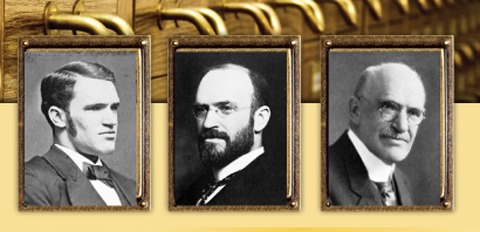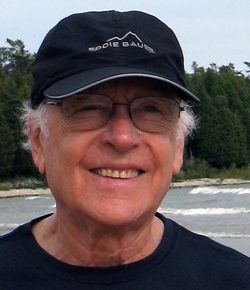
While most Americans know very little about ALA founder Melvil Dewey (1851–1931), nearly all are familiar with his signature achievement, the Dewey Decimal Classification system, which today governs the arrangement of library books in nearly 150 countries. Surprisingly, this ingenious search engine—the Google of its day—that he first published in 1876 reveals much about the man himself, as it was a direct outgrowth of the inner workings of his own mind.
This native of New York State’s burned-over district never could stop thinking about the number 10. As an adolescent, Dewey fell hard for the metric system, whose “great superiority,” as he wrote in a high school essay, “over all others consists in the fact that all its scales are purely decimal.” Considering 10 a magic number, Dewey was convinced that it was no accident that he had been born on December 10, the same day that the French National Assembly adopted the platinum meter bar back in 1799.
At the Lake Placid Club, the cooperative resort in the Adirondacks that he established in 1895, the number 10 ruled. He charged members a $10 annual fee. (Lifetime memberships were $1,000, or $103.) He also required that guests turn off their lights at exactly 10 p.m.—the same time that the overnight train from the club left for Manhattan. This was a man who was addicted to writing 10-page letters and even preferred to “sleep decimally”—that is, 10 hours each night.
Moreover, Dewey’s worship of the number 10 was closely related to other obsessions that also dated back to his boyhood. At age 5, he was already alphabetizing the spices in his mother’s pantry. A perfectionist, Dewey was preoccupied with order, details, rules, and lists—symptoms that are the hallmarks of a form of mental illness known to psychiatrists as obsessive-compulsive personality disorder (OCPD).
As I argue in my recent book, America’s Obsessives: The Compulsive Energy That Built a Nation—which also profiles several other icons, including US president and note-taker Thomas Jefferson, entrepreneurs Henry Heinz and Steve Jobs, and aviator Charles Lindbergh—when channeled constructively, obsessiveness can lead to staggering achievements. Though we tend to think of obsessives as dull plodders, they can also be movers and shakers capable of realizing their extraordinary visions. Without his slew of neurotic tics, the 24-year-old Dewey might never have been able to organize the convention of librarians at the Centennial Exposition in Philadelphia in 1876, which, in turn, created the American Library Association (ALA).
The difference one letter makes
OCPD is often confused with its close cousin, obsessive-compulsive disorder (OCD). To illustrate the difference between OCPD and OCD, consider the case of another Mel, the novelist Melvin Udall, who is the protagonist of the 1997 Hollywood blockbuster As Good as It Gets. The Udall character, for which Jack Nicholson won an Oscar, is a classic OCD sufferer, beset by numerous obsessions and compulsions that dramatically restrict his everyday life. A germophobe, Udall is addicted to hourlong showers and using two bars of new soap each time he washes his hands. Refusing to use the silverware in restaurants, he carries his own plasticware with him at all times. The plot revolves around how these rituals impede his romance with the female lead, played by Helen Hunt.
Individuals with OCPD have similar obsessions and compulsions—cleanliness is also a sine qua non—but their internal experience is very different. Instead of becoming debilitated, they are energized by the things they can’t stop thinking about or doing.
The late Steve Jobs was a neatness nut who donned white gloves to check for dust on the floor of the first Apple factory in Fremont, California. Reasoning that if his workers couldn’t get the small things right, they wouldn’t get the big things right either, Jobs experienced nothing but pride in his spick-and-span facility. His primary obsession was designing “insanely great products”—an activity he loved more than life itself. When lying on his bed in a cancer ward, Jobs once ripped off his oxygen mask, railing that he hated its design; he then insisted his doctors come up with five new models on the double.
OCPD is considered a psychiatric disorder—noted in DSM-5—because it is also associated with interpersonal problems. Like Dewey and other obsessive American icons, Jobs had trouble getting along with other people. This tough taskmaster would fly off the handle whenever he spotted a typo in a company memo. Employees were reluctant to ride the elevator with him, fearing they might be fired by the time the door reopened. Jobs’s tempestuousness was precisely what led the Apple board to fire him in the mid-1980s. Rehired a decade later, Jobs showed just a tad more self-control during his spectacularly successful second go-round with the company.
The fruits of a compulsion
Dewey’s obsessions were also responsible for both the remarkable highs and the dispiriting lows of his career. He was a master at launching and beefing up organizations, but like Jobs, because of his mercurial temperament, he often had difficulty running them. He turned the New York State Library (NYSL) in Albany into an exemplary national institution during his nearly two-decade-long tenure that ended in 1905. As New York Governor Theodore Roosevelt noted in 1899, the library “has more than doubled its efficiency within the past ten years and is an inspiration to intellectual life throughout the State” (Journal of the Assembly of the State of New York, January 4, 1899, p. 29).
In Albany, Dewey came up with numerous innovations, such as the first library for the blind, the first interlibrary loan program, and the first children’s library. However, he also managed to alienate many colleagues with his unpredictable and demanding behavior. As the Brooklyn Daily Eagle reported in an editorial on December 18, 1899, his “queering personality” often put him “on the defensive with many state officers.” Like Jobs, Dewey also frequently rattled his employees: He would not hesitate to dock them half a day’s pay for arriving just one-twelfth of an hour—five minutes—late.
The compulsion that eventually forced him to retire from the library world in his early 50s was his womanizing, a common character flaw of obsessives, who typically lack the social skills to develop mutually satisfying intimate relationships. As generations of librarians have whispered, Dewey’s eagerness to surround himself with attractive young women may well have been what prompted him to start the world’s first library school, the School of Library Economy at Columbia College in 1887.
While Dewey, who was then married to Annie Godfrey, the former librarian of Wellesley College, didn’t actually request the bust sizes of prospective students (as it was rumored), he did require photos, explaining that “you cannot polish a pumpkin.” But there is no archival evidence suggesting that he ever acted inappropriately at Columbia where 90% of his students were women. However, at some point during his sojourn at NYSL, to which he transferred his library school two years later, he appears to have evolved into a serial hugger and kisser.
Library Lothario
According to eyewitnesses, Dewey repeatedly subjected his personal assistants Florence Woodworth and May Seymour, both former students at Columbia, to surprise squeezes. These women, who both lived in Dewey’s Albany home, didn’t register a formal complaint; neither did Adelaide Hasse, head of the Public Documents Division at the New York Public Library, who told several contemporaries of his excessively flirtatious behavior during her visit to Albany in 1905.
However, that same year, during a 10-day ALA-sponsored trip to Alaska, Dewey made unwelcome advances on four prominent librarians who felt that they had no choice but to speak up to Association officials. As a result, Dewey, like Jobs, was ostracized from the organization that he had founded—in 1876, he had signed in as ALA member number one—for the next 20 years. He was such a persona non grata that in 1915, ALA President Mary Wright Plummer, who had been a student in his first class at Columbia, vowed to refuse to meet him as long as she remained in the profession.
Summing up the matter a decade later, Tessa Kelso, the one-time head of the Los Angeles Public Library, noted, “For many years women librarians have been the special prey of Mr. Dewey in a series of outrages upon decency.” Dewey, who married again soon after the death of his first wife in 1922, never managed to change his ways. In 1930, the 78-year-old head of the Lake Placid Club had to fork over some $2,000 to settle a sexual harassment suit brought by a former secretary.
Written under the watchful eye of surviving family members, the early biographies airbrush Dewey’s quirks and present him as a secular saint. In contrast, Irrepressible Reformer (1996), the definitive biography by Wayne A. Wiegand, retired professor of library and information studies at Florida State University, features a frank discussion of his dark side, as well as the 1905 sex scandal. “That there is so much to dislike about Melvil Dewey’s character,” Wiegand concluded, “may explain why his legacy has been understudied.”
Paradoxically, the very same obsessiveness that created havoc in his personal life helped generate his string of innovations. No matter how objectionable his behavior may have been at times, it’s hard to disagree with his first biographer, Grosvenor Dawe, who summed up his career as follows: “In brief, he saw things that were not and then made them exist.”
JOSHUA KENDALL is an award-winning journalist whose work has appeared in the Wall Street Journal, New York Times, Psychology Today, and Businessweek. His most recent book is America’s Obsessives: The Compulsive Energy That Built a Nation (Grand Central Publishing, 2013). He has also written biographies of Noah Webster and Peter Mark Roget.
In his book, America’s Obsessives: The Compulsive Energy That Built a Nation (2013), Joshua Kendall makes a careful distinction between obsessive-compulsive disorder (OCD), in which obsessions are unwelcome (think of Howard Hughes sitting naked in a “germ-free zone”—the middle of a hotel room), and obsessive-compulsive personality disorder (OCPD), in which obsessions are not only welcome but even pushed on others as desirable behavioral traits. ALA founder Melvil Dewey merits a chapter in Kendall’s compelling book. Research I did for Irrepressible Reformer: A Biography of Melvil Dewey (ALA, 1996) validates his conclusion.
“Use shorthand” in correspondence and note-taking, Dewey urged colleagues and subordinates, stressing all the time they would save in the process (his favorite method was David Phillip Lindsley’s tachigraphy).
“Adopt metric,” he told everyone in earshot, confident that the nation’s economy would accelerate if it joined the rest of the world in a common system of weights and measures.
“Practice simplified spelling,” which, if married to the adoption of metric, he was convinced, would shave two years off an 8th-grade education. (My favorite manifestation of this practice turned up on the menu of his Lake Placid Club as “stud prunes.” I’ll let readers figure that one out.)
WAYNE A. WIEGAND is F. William Summers Professor of Library and Information Studies at Florida State University in Tallahassee.


